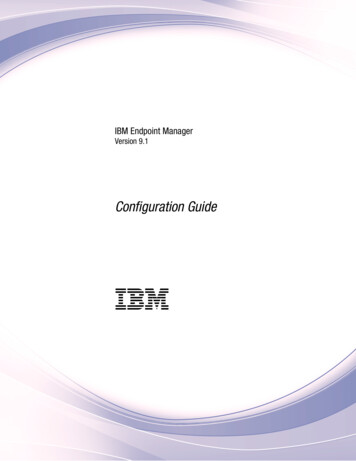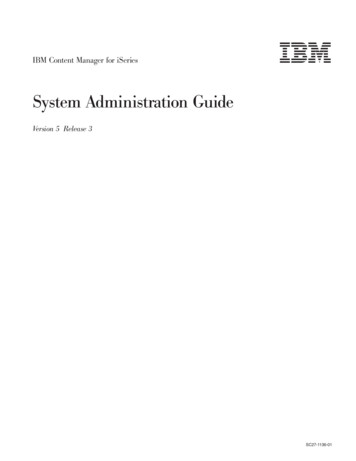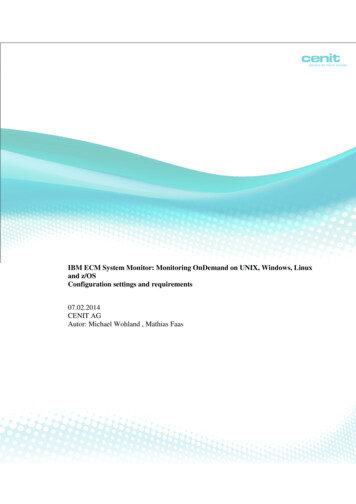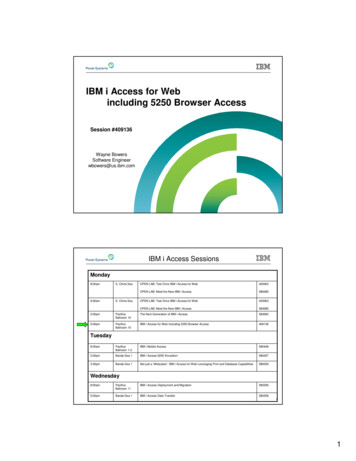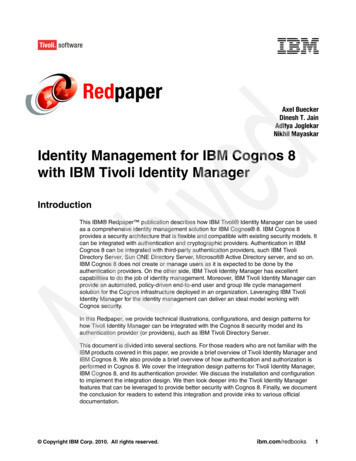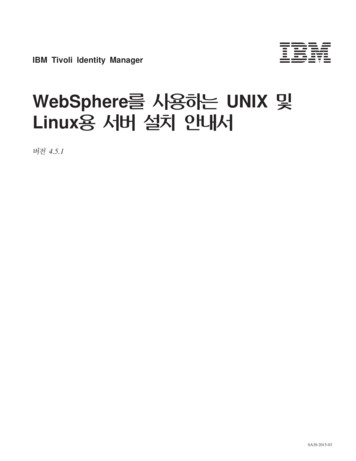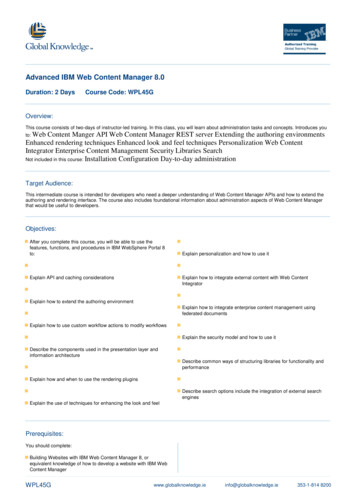
Transcription
Advanced IBM Web Content Manager 8.0Duration: 2 DaysCourse Code: WPL45GOverview:This course consists of two-days of instructor-led training. In this class, you will learn about administration tasks and concepts. Introduces youto: WebContent Manger API Web Content Manager REST server Extending the authoring environmentsEnhanced rendering techniques Enhanced look and feel techniques Personalization Web ContentIntegrator Enterprise Content Management Security Libraries SearchNot included in this course: Installation Configuration Day-to-day administrationTarget Audience:This intermediate course is intended for developers who need a deeper understanding of Web Content Manager APIs and how to extend theauthoring and rendering interface. The course also includes foundational information about administration aspects of Web Content Managerthat would be useful to developers.Objectives:After you complete this course, you will be able to use thefeatures, functions, and procedures in IBM WebSphere Portal 8to:Explain API and caching considerationsExplain personalization and how to use itExplain how to integrate external content with Web ContentIntegratorExplain how to extend the authoring environmentExplain how to integrate enterprise content management usingfederated documentsExplain how to use custom workflow actions to modify workflowsExplain the security model and how to use itDescribe the components used in the presentation layer andinformation architectureDescribe common ways of structuring libraries for functionality andperformanceExplain how and when to use the rendering pluginsDescribe search options include the integration of external searchenginesExplain the use of techniques for enhancing the look and feelPrerequisites:You should complete:Building Websites with IBM Web Content Manager 8, orequivalent knowledge of how to develop a website with IBM WebContent ledge.ie353-1-814 8200
You should have:experience using Java, JSP, HTML and CSSexperience in website development and maintenanceexperience in existing workflow and security owledge.ie353-1-814 8200
Content:lineAPI overview of workspace, renderingcontext, manage content, search contentOverview of the REST services capabilityAPIs for authoring environmentCustom workflow overviewOverview of navigators, menus, site areasOverview of optionsPresentation template overview of thedifferent ways to change styleOverview of when to use personalization andprofilingOverview of IBM Web Content Integrator(concept of producer and consumer)Overview of how WCM retrieves contentfrom ECM servers (federated documents)Review roles (user, contributor, editor,manager, administrator, delegator, privilegeduser)Review Library options, such as setting up acommon library for shared imagesReview Search options: out-of-the-boxsearch, Omnifind, third-party search (suchas Google)lineCache considerationsUnit 2: REST services for Web ContentManagerService entry pointsAccess levelsQuery service and parametersUsing REST services to create, delete, orupdate web content itemsUnit 3: Extending the authoring environmentLook and feel optionsPlugin options (file upload class, textprovider class)Unit 4: Extending change management withcustom workflowsUnit 5: Overview of the presentation layerInformation architecture and implementationHow they are relatedWhen to use which oneOverview of portal page structure (extensionof site framework)How it can be used to dynamically generatenavigationUnit 6: Enhanced renderingCustom launch pagesEnhanced menu componentsDynamic content based on the content IDRendering pluginsUnit 7: Enhancing the look and feelTheme customization (portal)Combined Portal and WCM navigation(generated integrated breadcrumbs)Cascading CSS (content, components,presentation templates)Inline HTML style (content, components,presentation templates)Unit 8: PersonalizationWPL45GlineCache considerationsUnit 2: REST services for Web ContentManagerService entry pointsAccess levelsQuery service and parametersUsing REST services to create, delete, orupdate web content itemsUnit 3: Extending the authoringenvironmentLook and feel optionsPlugin options (file upload class, textprovider class)Unit 4: Extending change managementwith custom workflowsUnit 5: Overview of the presentation layerInformation architecture andimplementationHow they are relatedWhen to use which oneOverview of portal page structure(extension of site framework)How it can be used to dynamicallygenerate navigationUnit 6: Enhanced renderingCustom launch pagesEnhanced menu componentsDynamic content based on the content IDRendering pluginsUnit 7: Enhancing the look and feelTheme customization (portal)Combined Portal and WCM navigation(generated integrated breadcrumbs)Cascading CSS (content, components,presentation templates)Inline HTML style (content, components,presentation templates)Unit 8: PersonalizationPerformance considerations forpersonalizationBest practices for personalizationUnit 9: Integrating content with IBM WebContent IntegratorFeed formatIssues with embedded links in feedsUnit 10: Integrating ECM using federateddocumentsOverview of integrationSecurity considerations (SSO withWebSphere Application Server)Unit 11: SecurityReview predefines groups (anonymous,authenticated, users and user groups, alluser groups)Explain relationship between WebSpherePortal and Web Content ManagersecurityReview interface for assigning accesslevelsConsiderations for security in applicationsUnit 12: Working with librariesDiscuss when multiple libraries arewww.globalknowledge.ielineAPI overview of workspace, renderingcontext, manage content, search contentOverview of the REST services capabilityAPIs for authoring environmentCustom workflow overviewOverview of navigators, menus, site areasOverview of optionsPresentation template overview of thedifferent ways to change styleOverview of when to use personalizationand profilingOverview of IBM Web Content Integrator(concept of producer and consumer)Overview of how WCM retrieves contentfrom ECM servers (federated documents)Review roles (user, contributor, editor,manager, administrator, delegator,privileged user)Review Library options, such as setting upa common library for shared imagesReview Search options: out-of-the-boxsearch, Omnifind, third-party search (suchas Google)lineCache considerationsUnit 2: REST services for Web ContentManagerService entry pointsAccess levelsQuery service and parametersUsing REST services to create, delete, orupdate web content itemsUnit 3: Extending the authoringenvironmentLook and feel optionsPlugin options (file upload class, textprovider class)Unit 4: Extending change managementwith custom workflowsUnit 5: Overview of the presentation layerInformation architecture andimplementationHow they are relatedWhen to use which oneOverview of portal page structure(extension of site framework)How it can be used to dynamicallygenerate navigationUnit 6: Enhanced renderingCustom launch pagesEnhanced menu componentsDynamic content based on the content IDRendering pluginsUnit 7: Enhancing the look and feelTheme customization (portal)Combined Portal and WCM navigation(generated integrated breadcrumbs)Cascading CSS (content, components,presentation templates)Inline HTML style (content, components,info@globalknowledge.ie353-1-814 8200
Performance considerations forpersonalizationBest practices for personalizationUnit 9: Integrating content with IBM WebContent IntegratorFeed formatIssues with embedded links in feedsUnit 10: Integrating ECM using federateddocumentsOverview of integrationSecurity considerations (SSO withWebSphere Application Server)Unit 11: SecurityReview predefines groups (anonymous,authenticated, users and user groups, alluser groups)Explain relationship between WebSpherePortal and Web Content Manager securityReview interface for assigning access levelsConsiderations for security in applicationsUnit 12: Working with librariesDiscuss when multiple libraries arebeneficial (such as library for each companydivision)Review library performance considerationReview library techniques such as creatinglabels, restoring content based on labels,and disabling versus deleting a libraryUnit 13: SearchBenefits and limitations of each optionArchitecture of each optionIntegrating with custom fieldslineCache considerationsUnit 2: REST services for Web ContentManagerService entry pointsAccess levelsQuery service and parametersUsing REST services to create, delete, orupdate web content itemsUnit 3: Extending the authoring environmentLook and feel optionsPlugin options (file upload class, textprovider class)Unit 4: Extending change management withcustom workflowsUnit 5: Overview of the presentation layerInformation architecture and implementationHow they are relatedWhen to use which oneOverview of portal page structure (extensionof site framework)How it can be used to dynamically generatenavigationUnit 6: Enhanced renderingCustom launch pagesEnhanced menu componentsDynamic content based on the content IDRendering pluginsUnit 7: Enhancing the look and feelTheme customization (portal)Combined Portal and WCM navigation(generated integrated breadcrumbs)WPL45Gbeneficial (such as library for eachcompany division)Review library performance considerationReview library techniques such ascreating labels, restoring content basedon labels, and disabling versus deleting alibraryUnit 13: SearchBenefits and limitations of each optionArchitecture of each optionIntegrating with custom fieldslineAPI overview of workspace, renderingcontext, manage content, search contentOverview of the REST services capabilityAPIs for authoring environmentCustom workflow overviewOverview of navigators, menus, siteareasOverview of optionsPresentation template overview of thedifferent ways to change styleOverview of when to use personalizationand profilingOverview of IBM Web Content Integrator(concept of producer and consumer)Overview of how WCM retrieves contentfrom ECM servers (federated documents)Review roles (user, contributor, editor,manager, administrator, delegator,privileged user)Review Library options, such as settingup a common library for shared imagesReview Search options: out-of-the-boxsearch, Omnifind, third-party search(such as Google)lineCache considerationsUnit 2: REST services for Web ContentManagerService entry pointsAccess levelsQuery service and parametersUsing REST services to create, delete, orupdate web content itemsUnit 3: Extending the authoringenvironmentLook and feel optionsPlugin options (file upload class, textprovider class)Unit 4: Extending change managementwith custom workflowsUnit 5: Overview of the presentation layerInformation architecture andimplementationHow they are relatedWhen to use which oneOverview of portal page structure(extension of site framework)How it can be used to dynamicallygenerate navigationUnit 6: Enhanced renderingwww.globalknowledge.iepresentation templates)Unit 8: PersonalizationPerformance considerations forpersonalizationBest practices for personalizationUnit 9: Integrating content with IBM WebContent IntegratorFeed formatIssues with embedded links in feedsUnit 10: Integrating ECM using federateddocumentsOverview of integrationSecurity considerations (SSO withWebSphere Application Server)Unit 11: SecurityReview predefines groups (anonymous,authenticated, users and user groups, alluser groups)Explain relationship between WebSpherePortal and Web Content Manager securityReview interface for assigning accesslevelsConsiderations for security in applicationsUnit 12: Working with librariesDiscuss when multiple libraries arebeneficial (such as library for eachcompany division)Review library performance considerationReview library techniques such as creatinglabels, restoring content based on labels,and disabling versus deleting a libraryUnit 13: SearchBenefits and limitations of each optionArchitecture of each optionIntegrating with custom fieldslineCache considerationsUnit 2: REST services for Web ContentManagerService entry pointsAccess levelsQuery service and parametersUsing REST services to create, delete, orupdate web content itemsUnit 3: Extending the authoringenvironmentLook and feel optionsPlugin options (file upload class, textprovider class)Unit 4: Extending change managementwith custom workflowsUnit 5: Overview of the presentation layerInformation architecture andimplementationHow they are relatedWhen to use which oneOverview of portal page structure(extension of site framework)How it can be used to dynamicallygenerate navigationUnit 6: Enhanced renderingCustom launch pagesEnhanced menu componentsDynamic content based on the content IDinfo@globalknowledge.ie353-1-814 8200
Cascading CSS (content, components,presentation templates)Inline HTML style (content, components,presentation templates)Unit 8: PersonalizationPerformance considerations forpersonalizationBest practices for personalizationUnit 9: Integrating content with IBM WebContent IntegratorFeed formatIssues with embedded links in feedsUnit 10: Integrating ECM using federateddocumentsOverview of integrationSecurity considerations (SSO withWebSphere Application Server)Unit 11: SecurityReview predefines groups (anonymous,authenticated, users and user groups, alluser groups)Explain relationship between WebSpherePortal and Web Content Manager securityReview interface for assigning access levelsConsiderations for security in applicationsUnit 12: Working with librariesDiscuss when multiple libraries arebeneficial (such as library for each companydivision)Review library performance considerationReview library techniques such as creatinglabels, restoring content based on labels,and disabling versus deleting a libraryUnit 13: SearchBenefits and limitations of each optionArchitecture of each optionIntegrating with custom fieldslineAPI overview of workspace, renderingcontext, manage content, search contentOverview of the REST services capabilityAPIs for authoring environmentCustom workflow overviewOverview of navigators, menus, site areasOverview of optionsPresentation template overview of thedifferent ways to change styleOverview of when to use personalization andprofilingOverview of IBM Web Content Integrator(concept of producer and consumer)Overview of how WCM retrieves contentfrom ECM servers (federated documents)Review roles (user, contributor, editor,manager, administrator, delegator, privilegeduser)Review Library options, such as setting up acommon library for shared imagesReview Search options: out-of-the-boxsearch, Omnifind, third-party search (suchas Google)lineWPL45GCustom launch pagesEnhanced menu componentsDynamic content based on the content IDRendering pluginsUnit 7: Enhancing the look and feelTheme customization (portal)Combined Portal and WCM navigation(generated integrated breadcrumbs)Cascading CSS (content, components,presentation templates)Inline HTML style (content, components,presentation templates)Unit 8: PersonalizationPerformance considerations forpersonalizationBest practices for personalizationUnit 9: Integrating content with IBM WebContent IntegratorFeed formatIssues with embedded links in feedsUnit 10: Integrating ECM using federateddocumentsOverview of integrationSecurity considerations (SSO withWebSphere Application Server)Unit 11: SecurityReview predefines groups (anonymous,authenticated, users and user groups, alluser groups)Explain relationship between WebSpherePortal and Web Content ManagersecurityReview interface for assigning accesslevelsConsiderations for security in applicationsUnit 12: Working with librariesDiscuss when multiple libraries arebeneficial (such as library for eachcompany division)Review library performance considerationReview library techniques such ascreating labels, restoring content basedon labels, and disabling versus deleting alibraryUnit 13: SearchBenefits and limitations of each optionArchitecture of each optionIntegrating with custom fieldslineCache considerationsUnit 2: REST services for Web ContentManagerService entry pointsAccess levelsQuery service and parametersUsing REST services to create, delete, orupdate web content itemsUnit 3: Extending the authoringenvironmentLook and feel optionsPlugin options (file upload class, textprovider class)Unit 4: Extending change managementwith custom workflowswww.globalknowledge.ieRendering pluginsUnit 7: Enhancing the look and feelTheme customization (portal)Combined Portal and WCM navigation(generated integrated breadcrumbs)Cascading CSS (content, components,presentation templates)Inline HTML style (content, components,presentation templates)Unit 8: PersonalizationPerformance considerations forpersonalizationBest practices for personalizationUnit 9: Integrating content with IBM WebContent IntegratorFeed formatIssues with embedded links in feedsUnit 10: Integrating ECM using federateddocumentsOverview of integrationSecurity considerations (SSO withWebSphere Application Server)Unit 11: SecurityReview predefines groups (anonymous,authenticated, users and user groups, alluser groups)Explain relationship between WebSpherePortal and Web Content Manager securityReview interface for assigning accesslevelsConsiderations for security in applicationsUnit 12: Working with librariesDiscuss when multiple libraries arebeneficial (such as library for eachcompany division)Review library performance considerationReview library techniques such as creatinglabels, restoring content based on labels,and disabling versus deleting a libraryUnit 13: SearchBenefits and limitations of each optionArchitecture of each optionIntegrating with custom fieldslineCache considerationsUnit 2: REST services for Web ContentManagerService entry pointsAccess levelsQuery service and parametersUsing REST services to create, delete, orupdate web content itemsUnit 3: Extending the authoringenvironmentLook and feel optionsPlugin options (file upload class, textprovider class)Unit 4: Extending change managementwith custom workflowsUnit 5: Overview of the presentation layerInformation architecture andimplementationHow they are relatedWhen to use which oneinfo@globalknowledge.ie353-1-814 8200
Cache considerationsUnit 2: REST services for Web ContentManagerService entry pointsAccess levelsQuery service and parametersUsing REST services to create, delete, orupdate web content itemsUnit 3: Extending the authoring environmentLook and feel optionsPlugin options (file upload class, textprovider class)Unit 4: Extending change management withcustom workflowsUnit 5: Overview of the presentation layerInformation architecture and implementationHow they are relatedWhen to use which oneOverview of portal page structure (extensionof site framework)How it can be used to dynamically generatenavigationUnit 6: Enhanced renderingCustom launch pagesEnhanced menu componentsDynamic content based on the content IDRendering pluginsUnit 7: Enhancing the look and feelTheme customization (portal)Combined Portal and WCM navigation(generated integrated breadcrumbs)Cascading CSS (content, components,presentation templates)Inline HTML style (content, components,presentation templates)Unit 8: PersonalizationPerformance considerations forpersonalizationBest practices for personalizationUnit 9: Integrating content with IBM WebContent IntegratorFeed formatIssues with embedded links in feedsUnit 10: Integrating ECM using federateddocumentsOverview of integrationSecurity considerations (SSO withWebSphere Application Server)Unit 11: SecurityReview predefines groups (anonymous,authenticated, users and user groups, alluser groups)Explain relationship between WebSpherePortal and Web Content Manager securityReview interface for assigning access levelsConsiderations for security in applicationsUnit 12: Working with librariesDiscuss when multiple libraries arebeneficial (such as library for each companydivision)Review library performance considerationReview library techniques such as creatinglabels, restoring content based on labels,and disabling versus deleting a libraryUnit 13: SearchBenefits and limitations of each optionWPL45GUnit 5: Overview of the presentation layerInformation architecture andimplementationHow they are relatedWhen to use which oneOverview of portal page structure(extension of site framework)How it can be used to dynamicallygenerate navigationUnit 6: Enhanced renderingCustom launch pagesEnhanced menu componentsDynamic content based on the content IDRendering pluginsUnit 7: Enhancing the look and feelTheme customization (portal)Combined Portal and WCM navigation(generated integrated breadcrumbs)Cascading CSS (content, components,presentation templates)Inline HTML style (content, components,presentation templates)Unit 8: PersonalizationPerformance considerations forpersonalizationBest practices for personalizationUnit 9: Integrating content with IBM WebContent IntegratorFeed formatIssues with embedded links in feedsUnit 10: Integrating ECM using federateddocumentsOverview of integrationSecurity considerations (SSO withWebSphere Application Server)Unit 11: SecurityReview predefines groups (anonymous,authenticated, users and user groups, alluser groups)Explain relationship between WebSpherePortal and Web Content ManagersecurityReview interface for assigning accesslevelsConsiderations for security in applicationsUnit 12: Working with librariesDiscuss when multiple libraries arebeneficial (such as library for eachcompany division)Review library performance considerationReview library techniques such ascreating labels, restoring content basedon labels, and disabling versus deleting alibraryUnit 13: SearchBenefits and limitations of each optionArchitecture of each optionIntegrating with custom fieldslineCache considerationsUnit 2: REST services for Web ContentManagerService entry pointsAccess levelswww.globalknowledge.ieOverview of portal page structure(extension of site framework)How it can be used to dynamicallygenerate navigationUnit 6: Enhanced renderingCustom launch pagesEnhanced menu componentsDynamic content based on the content IDRendering pluginsUnit 7: Enhancing the look and feelTheme customization (portal)Combined Portal and WCM navigation(generated integrated breadcrumbs)Cascading CSS (content, components,presentation templates)Inline HTML style (content, components,presentation templates)Unit 8: PersonalizationPerformance considerations forpersonalizationBest practices for personalizationUnit 9: Integrating content with IBM WebContent IntegratorFeed formatIssues with embedded links in feedsUnit 10: Integrating ECM using federateddocumentsOverview of integrationSecurity considerations (SSO withWebSphere Application Server)Unit 11: SecurityReview predefines groups (anonymous,authenticated, users and user groups, alluser groups)Explain relationship between WebSpherePortal and Web Content Manager securityReview interface for assigning accesslevelsConsiderations for security in applicationsUnit 12: Working with librariesDiscuss when multiple libraries arebeneficial (such as library for eachcompany division)Review library performance considerationReview library techniques such as creatinglabels, restoring content based on labels,and disabling versus deleting a libraryUnit 13: SearchBenefits and limitations of each optionArchitecture of each optionIntegrating with custom fieldslineAPI overview of workspace, renderingcontext, manage content, search contentOverview of the REST services capabilityAPIs for authoring environmentCustom workflow overviewOverview of navigators, menus, site areasOverview of optionsPresentation template overview of thedifferent ways to change styleOverview of when to use personalizationand profilingOverview of IBM Web Content Integratorinfo@globalknowledge.ie353-1-814 8200
Architecture of each optionIntegrating with custom fieldslineCache considerationsUnit 2: REST services for Web ContentManagerService entry pointsAccess levelsQuery service and parametersUsing REST services to create, delete, orupdate web content itemsUnit 3: Extending the authoring environmentLook and feel optionsPlugin options (file upload class, textprovider class)Unit 4: Extending change management withcustom workflowsUnit 5: Overview of the presentation layerInformation architecture and implementationHow they are relatedWhen to use which oneOverview of portal page structure (extensionof site framework)How it can be used to dynamically generatenavigationUnit 6: Enhanced renderingCustom launch pagesEnhanced menu componentsDynamic content based on the content IDRendering pluginsUnit 7: Enhancing the look and feelTheme customization (portal)Combined Portal and WCM navigation(generated integrated breadcrumbs)Cascading CSS (content, components,presentation templates)Inline HTML style (content, components,presentation templates)Unit 8: PersonalizationPerformance considerations forpersonalizationBest practices for personalizationUnit 9: Integrating content with IBM WebContent IntegratorFeed formatIssues with embedded links in feedsUnit 10: Integrating ECM using federateddocumentsOverview of integrationSecurity considerations (SSO withWebSphere Application Server)Unit 11: SecurityReview predefines groups (anonymous,authenticated, users and user groups, alluser groups)Explain relationship between WebSpherePortal and Web Content Manager securityReview interface for assigning access levelsConsiderations for security in applicationsUnit 12: Working with librariesDiscuss when multiple libraries arebeneficial (such as library for each companydivision)Review library performance considerationWPL45GQuery service and parametersUsing REST services to create, delete, orupdate web content itemsUnit 3: Extending the authoringenvironmentLook and feel optionsPlugin options (file upload class, textprovider class)Unit 4: Extending change managementwith custom workflowsUnit 5: Overview of the presentation layerInformation architecture andimplementationHow they are relatedWhen to use which oneOverview of portal page structure(extension of site framework)How it can be used to dynamicallygenerate navigationUnit 6: Enhanced renderingCustom launch pagesEnhanced menu componentsDynamic content based on the content IDRendering pluginsUnit 7: Enhancing the look and feelTheme customization (portal)Combined Portal and WCM navigation(generated integrated breadcrumbs)Cascading CSS (content, components,presentation templates)Inline HTML style (content, components,presentation templates)Unit 8: PersonalizationPerformance considerations forpersonalizationBest practices for personalizationUnit 9: Integrating content with IBM WebContent IntegratorFeed formatIssues with embedded links in feedsUnit 10: Integrating ECM using federateddocumentsOverview of integrationSecurity considerations (SSO withWebSphere Application Server)Unit 11: SecurityReview predefines groups (anonymous,authenticated, users and user groups, alluser groups)Explain relationship between WebSpherePortal and Web Content ManagersecurityReview interface for assigning accesslevelsConsiderations for security in applicationsUnit 12: Working with librariesDiscuss when multiple libraries arebeneficial (such as library for eachcompany division)Review library performance considerationReview library techniques such ascreating labels, restoring content basedon labels, and disabling versus deleting alibraryUnit 13: SearchBenefits and limitations of each optionwww.globalknowledge.ie(concept of producer and consumer)Overview of how WCM retrieves contentfrom ECM servers (federated documents)Review roles (user, contributor, editor,manager, administrator, delegator,privileged user)Review Library options, such as setting upa common library for shared imagesReview Search options: out-of-the-boxsearch, Omnifind, third-party search (suchas Google)lineCache considerationsUnit 2: REST services for Web ContentManagerService entry pointsAccess levelsQuery service and parametersUsing REST services to create, delete, orupdate web content itemsUnit 3: Extending the authoringenvironmentLook and feel optionsPlugin options (file upload class, textprovider class)Unit 4: Extending change managementwith custom workflowsUnit 5: Overview of the presentation layerInformation architecture andimplementationHow they are relatedWhen to use which oneOverview of portal page structure(extension of site framework)How it can be used to dynamicallygenerate navigationUnit 6: Enhanced renderingCustom launch pagesEnhanced menu componentsDynamic content based on the content IDRendering pluginsUnit 7: Enhancing the look and feelTheme customization (portal)Combined Portal and WCM navigation(generated integrated breadcrumbs)Cascading CSS (content, components,presentation templates)Inline HTML style (content, components,presentation templates)Unit 8: PersonalizationPerformance considerations forpersonalizationBest practices for personalizationUnit 9: Integrating content with IBM WebContent IntegratorFeed formatIssues with embedded links in feedsUnit 10: Integrating ECM using federateddocumentsOverview of integrationSecurity considerations (SSO withWebSphere Application Server)Unit 11: SecurityReview predefines groups (anonymous,info@globalknowledge.ie353-1-814 8200
Review library techniques such as creatinglabels, restoring content based on labels,and disabling versus deleting a libraryUnit 13: SearchBenefits and limitations of each optionArchitecture of each optionIntegrating with custom fieldslineCache considerationsUnit 2: REST services for Web ContentManagerService entry pointsAccess levelsQuery service and parametersUsing REST services to create, delete, orupdate web content itemsUnit 3: Extending the authoring environmentLook and feel optionsPlugin options (file upload class, textprovider class)Unit 4: Extending change management withcustom workflowsUnit 5: Overview of the presentation layerInformation architecture and implementationHow they are relatedWhen to use which oneOverview of portal page structu
Advanced IBM Web Content Manager 8.0 Duration: 2 Days Course Code: WPL45G Overview: This course consists of two-days of instructor-led training. In this class, you will learn about administration tasks and concepts. Introduces you to: Web Content Manger API Web Content Manager REST server Extending the authoring environments

